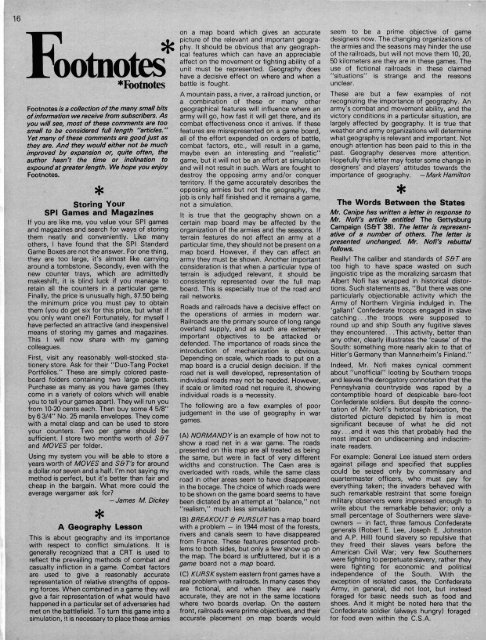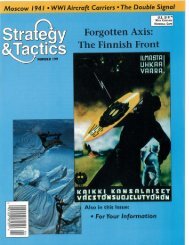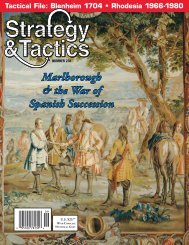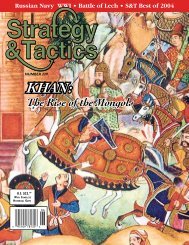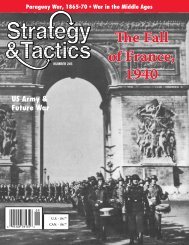Footnotes is a collection of <strong>the</strong> many small bitsof information we receive from subscribers. Asyou will see, most of <strong>the</strong>se comments are toosmall to be considered full length "articles."Yet many of <strong>the</strong>se comments are good just as<strong>the</strong>y are. And <strong>the</strong>y would ei<strong>the</strong>r not be muchimproved by expansion or, quite often, <strong>the</strong>author hasn't <strong>the</strong> time or inclination toexpound at greater length. We hope you enjoyFootnotes.*Storing YourSPI Games and MagazinesIf you are like me, you value your SPI gamesand magazines and search for ways of storing<strong>the</strong>m neatly and conveniently. Like manyo<strong>the</strong>rs, I have found that <strong>the</strong> SPI StandardGame Boxes are not <strong>the</strong> answer. For one thing,<strong>the</strong>y are too large, it's almost like carryingaround a tombstone. Secondly, even with <strong>the</strong>new counter trays, which are admittedlymakeshift, it is blind luck if you manage toretain all <strong>the</strong> counters in a particular game.Finally, <strong>the</strong> price is unusually high, $7.50 being<strong>the</strong> minimum price you must pay to obtain<strong>the</strong>m (you do get six for this price, but what ifyou only want one?) Fortunately, for myself Ihave perfected an attractive (and inexpensive)means of storing my games and magazines.This I will now share with my gamingcolleagues.First, visit any reasonably well-stocked ,stationerystore. Ask for <strong>the</strong>ir "Duo-Tang PocketPortfolios." These are simply colored pasteboardfolders containing two large pockets.Purchase as many as you have games (<strong>the</strong>ycome in a variety of colors which will enableyou to tell your games apart). They will run youfrom 10-20 cents each. Then buy some 4 518"by 6 314" No. 25 manila envelopes. They comewith a metal clasp and can be used to storeyour counters. Two per game should besufficient. I store two months worth of S&Tand MOVES per folder.Using my system you will be able to store ayears worth of MOVES and S&T's for arounda dollar not seven and a half. I'm not saying mymethod is perfect, but it's better than fair andcheap in <strong>the</strong> bargain. What more could <strong>the</strong>average <strong>war</strong>gamer ask for?- James M. DickeyA Geography LessonThis is about geography and its importancewith respect to conflict simulations. It isgenerally recognized that a CRT is used toreflect <strong>the</strong> prevailing methods of combat andcasualty infliction in a game. Combat factorsare used to give a reasonably accuraterepresentation of relative strengths of opposingforces. When combined in a game <strong>the</strong>y willgive a fair representation of what would havehappened in a particular set of adversaries hadmet on <strong>the</strong> battlefield. To turn this game into asimulation, it is necessary to place <strong>the</strong>se armieson a map board which gives an accuratepicture of <strong>the</strong> relevant and important geography.It should be obvious that any geographicalfeatures which can have an appreciableaffect on <strong>the</strong> movement or fighting ability of aunit must be represented. Geography doeshave a decisive effect on where and when abattle is fought.A mountain pass, a river, a railroad junction, ora combination of <strong>the</strong>se or many o<strong>the</strong>rgeographical features will influence where anarmy will go, how fast it will get <strong>the</strong>re, and itscombat effectiveness once it arrives. If <strong>the</strong>sefeatures are misrepresented on a game board,all of <strong>the</strong> effort expended on orders of battle,combat factors, etc., will result in a game,maybe even an interesting and "realistic"game, but it will not be an effort at simulationand will not result in such. Wars are fought todestroy <strong>the</strong> opposing army andlor conquerterritory. If <strong>the</strong> game accurately describes <strong>the</strong>opposing armies but not <strong>the</strong> geography, <strong>the</strong>job is only half finished and it remains a game,not a simulation.It is true that <strong>the</strong> geography shown on acertain map board may be affected by <strong>the</strong>organization of <strong>the</strong> armies and <strong>the</strong> seasons. Ifterrain features do not affect an army at aparticular time, <strong>the</strong>y should not be present on amap board. However, if <strong>the</strong>y can affect anarmy <strong>the</strong>y must be shown. Ano<strong>the</strong>r importantconsideration is that when a particular type ofterrain is adjudged relevant, it should beconsistently represented over <strong>the</strong> full mapboard. This is especially true of <strong>the</strong> road andrail networks.Roads and railroads have a decisive effect on<strong>the</strong> operations of armies in modern <strong>war</strong>.Railroads are <strong>the</strong> primary source of long rangeoverland supply, and as such are extremelyimportant objectives to be attacked ordefended. The importance of roads since <strong>the</strong>introduction of mechanization is obvious.Depending on scale, which roads to put on amap board is a crucial design decision. If <strong>the</strong>road net is well developed, representation ofindividual roads may not be needed. However,if scale or limited road net require it, showingindividual roads is a necessity.The following are a few examples of poorjudgement in <strong>the</strong> use of geography in <strong>war</strong>games.(A) NORMANDY is an example of how not toshow a road net in a <strong>war</strong> game. The roadspresented on this map are all treated as being<strong>the</strong> same, but were in fact of very differentwidths and construction. The Caen area isoverloaded with roads, while <strong>the</strong> same classroad in o<strong>the</strong>r areas seem to have disappearedin <strong>the</strong> bocage. The choice of which roads wereto be shown on <strong>the</strong> game board seems to havebeen dictated by an attempt at "balance," not"realism," much less simulation.(B) BREAKOUT & PURSUIT has a map boardwith a problem - in 1944 most of <strong>the</strong> forests,rivers and canals seem to have disappearedfrom France. These features presented problemsto both sides, but only a few show up on<strong>the</strong> map. The board is untluttered, but it is agame board not a map board.(C) KURSKsystem eastern front games have areal problem with railroads. In many cases <strong>the</strong>yare fictional, and when <strong>the</strong>y are nearlyaccurate, <strong>the</strong>y are not in <strong>the</strong> same locationswhere two boards overlap. On <strong>the</strong> easternfront, railroads were prime objectives, and <strong>the</strong>iraccurate placement on map boards wouldseem to be a prime objective of gamedesigners now. The changing organizations of<strong>the</strong> armies and <strong>the</strong> seasons may hinder <strong>the</strong> useof <strong>the</strong> railroads, but will not move <strong>the</strong>m 10, 20,50 kilometers are <strong>the</strong>y are in <strong>the</strong>se games. Theuse of fictional railroads in <strong>the</strong>se claimed"situations" is strange and <strong>the</strong> reasonsunclear.These are but a few examples of notrecognizing <strong>the</strong> importance of geography. Anarmy's combat and movement ability, and <strong>the</strong>victory conditions in a particular situation, arelargely affected by geography. It is true thatwea<strong>the</strong>r and army organizations will determinewhat geography is relevant and important. Notenough attention has been paid to this in <strong>the</strong>past. Geography deserves more attention.Hopefully this letter may foster some change indesigners' and players' attitudes to<strong>war</strong>ds <strong>the</strong>importance of geography. -Mark HamiltonThe Words Between <strong>the</strong> StatesMr. Canipe has written a letter in response toMr. Nofi's article entitled The GettysburgCampaign (SBT 381. The letter is representativeof a number of o<strong>the</strong>rs. The letter ispresented unchanged. Mr. Nofi's rebuttalfollows.Really1 The caliber and standards of S&T aretoo high to have space wasted on suchjingoistic tripe as <strong>the</strong> moralizing sarcasm thatAlbert Nofi has wrapped in historical distortions.Such statements as, "But <strong>the</strong>re was oneparticularly objectionable activity which <strong>the</strong>Army of Nor<strong>the</strong>rn Virginia indulged in. The'gallant' Confederate troops engaged in slavecatching. . .<strong>the</strong> troops were supposed toround up and ship South any fugitive slaves<strong>the</strong>y encountered. . .This activity, better thanany o<strong>the</strong>r, clearly illustrates <strong>the</strong> 'cause' of <strong>the</strong>South: something more nearly akin to that ofHitler's Germany than Mannerheim's Finland."Indeed, Mr. Nofi makes cynical commentabout "unofficial" looting by Sou<strong>the</strong>rn troopsand leaves <strong>the</strong> derogatory connotation that <strong>the</strong>Pennsylvania countryside was raped by acontemptible hoard of despicable bare-footConfederate soldiers. But despite <strong>the</strong> connotationof Mr. Nofi's historical fabrication, <strong>the</strong>distorted picture depicted by him is mostsignificant because of what he did notsay.. .and it was this that probably had <strong>the</strong>most impact on undiscerning and indiscriminatereaders.For example: General Lee issued stern ordersagainst pillage and specified that suppliescould be seized only by commissary andquartermaster officers, who must pay foreverything taken; <strong>the</strong> invaders behaved withsuch remarkable restraint that some foreignmilitary observers were impressed enough towrite about <strong>the</strong> remarkable behavior; only asmall percentage of Sou<strong>the</strong>rners were slaveowners- in fact, three famous Confederategenerals (Robert E. Lee, Joseph E. Johnstonand A.P. Hill) found slavery so repulsive that<strong>the</strong>y freed <strong>the</strong>ir slaves years before <strong>the</strong>American Civil War; very few Sou<strong>the</strong>rnerswere fighting to perpetuate slavery, ra<strong>the</strong>r <strong>the</strong>ywere fighting for economic and politicalindependence of <strong>the</strong> South. With <strong>the</strong>exception of isolated cases, <strong>the</strong> ConfederateArmy, in general, did not loot, but insteadforaged for basic needs such as food andshoes. And it might be noted here that <strong>the</strong>Confederate soldier (always hungry) foragedfor food even within <strong>the</strong> C.S.A.
Certainly <strong>the</strong> Confederate solider was no angel biased to<strong>war</strong>ds <strong>the</strong> Communists, was very Rebuilt M60IM60A1 tanks are excellent withunless one wishes to make a comparative objective. . .yet, it offended many naive and/or <strong>the</strong> exception of <strong>the</strong> fact that 3 to 4 years ofanalogy between <strong>the</strong>soldier of Lee'sarmy and nationalistic readers and unfortunately you storage between rebuilt and issuance does<strong>the</strong> soldier of Sherman's armv. It is indeed orinted an editorial of a~oloav. tend to cause <strong>the</strong> rubber (such as road wheels.remarkable that <strong>the</strong> Sou<strong>the</strong>rn soldier behavedwith as much restraint as he did while in <strong>the</strong>lush and rich Pennsylvania country, considering<strong>the</strong> pillage and rape of Nor<strong>the</strong>rn Virginia by<strong>the</strong> undisciplined mob of potpourri optimisticallycalled <strong>the</strong> Army of <strong>the</strong> Potomac. TheIt is absurd to think that a historical writer canplease everyone, but it is not absurd toencourage a historical writer to tell <strong>the</strong> truth -especially when <strong>the</strong> truth helps nationalharmony. - M. E. Canipeseals, etc.) to deteriorate.MTOE for Europe is 90% of <strong>the</strong> full TOEauthorized for use by Army units in time of<strong>war</strong>. At <strong>the</strong> present time most units are closeto <strong>the</strong> full MTOE. However, a year or two agomust units were 70-85% of MTOE.Army of Nor<strong>the</strong>rn Virginia had (humanemotions being what <strong>the</strong>y are) every reason forA.A. Nofi responds:The 8th Infantry Division does indeed have fiveseekina venaeance while invadina Pennsvl- The first impression one gets from this letter is tank battalions, broken down as follows: 1stvania. tompared with Sherman's introduc$on that Mr. Canipe ought to go back and read Brigade-2 airborne infantry battalions-soonof "total" <strong>war</strong> and destruction during his "The Gettysburg Campaign" in SEtT 38. 1 say to be converted to mechanized infantry; 1march throuah Georaia and <strong>the</strong> Carolinas and this because his objections to several of my airborne infantry battalion, which is in Italy; 4th<strong>the</strong> destruct& of thYe Shenandoah valley-by comments are based on incomplete reading of Battalion 69th Armor-formed in 1972; 2ndano<strong>the</strong>r Nor<strong>the</strong>rn military mind, <strong>the</strong> Army of <strong>the</strong> article. For example, where he says Brigade-3 mechanized infantry battalions; 1stVirginia was a model of generous behavior "cynical comment about 'unofficial' looting" and 2nd Bns 69th Armor; 3rd Brigade-1to<strong>war</strong>ds <strong>the</strong> land and people of Pennsylvania. andso forth, he demonstrates that he failed to mechanized infantry battalion; 3rd and 5th Bnsread, three or four lines fur<strong>the</strong>r on, "And of 68th Armor, as well as <strong>the</strong> divisional cavalryThe not so subtle Nor<strong>the</strong>rn chauvinism of Nofi course looting is a perennial disease among squadron which is attached for administrativeis obvious in many o<strong>the</strong>r places of his work as soldiers." Similarly his comments about my purposes. - L.F. W. Beck, Lt, USAwell as bewildering contradictions. He would evaluation of Sherman and o<strong>the</strong>r Federalhave us to believe that <strong>the</strong>re was not much generals as being <strong>the</strong> equals or superiors of <strong>the</strong>difference in <strong>the</strong> soldiering qualities of Johnny Sou<strong>the</strong>rners also betray a lack of carefulReb and Billy Yank but that what differences reading, for I noted several times that <strong>the</strong> really Sniper! Free-For-All<strong>the</strong>re were ". . .were most evident at still good U. S. officers were all out in <strong>the</strong> West athigher ranks, in <strong>the</strong> corps and <strong>the</strong> army that rime. But this is mere nit picking, and Mr. Sniper! ha,s been played in many variations atcommands." It is ra<strong>the</strong>r perplexing from a Canipe seems to have tried hard to find nits to SPI. The one that has been most durable andpoint of logic to <strong>the</strong>n read that "Men such as pick. The real issue is one which he has been responsible for more 5 AM SaturdayGrant and Sherman were probably <strong>the</strong> equals approaches obliquely: he objects to my play than any o<strong>the</strong>r has been an every-manofLee as army commanders. . ." and that unsvmm<strong>the</strong>tic approach to <strong>the</strong> Sou<strong>the</strong>rn for-himself f ree-for-ail.. . . .". . .Jackson was one of <strong>the</strong> top corps cause. The rules are simole. First out some Sni~ercommanders of <strong>the</strong> <strong>war</strong>, probably surpassedMaybe Lee and <strong>the</strong> slave- counters into a cup. Ten riflemen, 5 MP'S,only by Sherman and Sheridan." Mr. Nofiholders, sou<strong>the</strong>rners 3 sa sand a couple of MG's make up <strong>the</strong> bestfinally concludes that "Sherman may well have fighting slavery, but for balanced mix. Then someone holds up <strong>the</strong> cupbeen <strong>the</strong> finest officer on ei<strong>the</strong>r side." <strong>the</strong> economic and political independence of and everyone picks one. Try not to smile tooConsidering <strong>the</strong> aforementioned statements of <strong>the</strong> South. Fin. But let us not forget that <strong>the</strong> much Or everyone will that you pickedMr. Nofi and considering that <strong>the</strong> population of economic system of <strong>the</strong> South was rooted in UP <strong>the</strong> Machine gun.<strong>the</strong> Confederate States of America was slavery and <strong>the</strong> ~olitical~roblem which led <strong>the</strong> Divide <strong>the</strong> map edge into as many sectors asoutnumbered 10 to 1 and that she had a veryprimitive base, <strong>the</strong>n why did <strong>the</strong> SouthSouth to demand independence was <strong>the</strong> factthat <strong>the</strong> rest of <strong>the</strong> nation was becoming<strong>the</strong>re are players. Decide who gets whichsector. All counters enter from his respectivesucceed in surviving for five years against such increasingly hostile to <strong>the</strong> ';oeculiar institu- ma0 edae.overwhelming odds and forces? It is nei<strong>the</strong>rremarkable nor surprising that she lost <strong>the</strong> <strong>war</strong>- that was inevitable - but that she survivedas long as she did.The United States won by attrition. If hersoldiers had been more or less equal and hertop generals equal or superior to those of <strong>the</strong>Confederate States, <strong>the</strong>n a <strong>war</strong> of attritionwould not have been necessary. I believe that<strong>the</strong> superior 'material resources and manpowerof <strong>the</strong> North certainly outweight anyhome-ground defense advantages that <strong>the</strong>South enjoyed.Be that as it may, Mr. Nofi did not write withhistorical objectivity in mind. Such antiquatedapproaches to<strong>war</strong>ds <strong>the</strong> emotional issues of<strong>the</strong> <strong>war</strong> per se (which he played on) are anoffense to readers seeking objective andquality works. Such writing belongs to <strong>the</strong>emotional period of <strong>the</strong> Nor<strong>the</strong>rn Press (circa1860) and not on <strong>the</strong> pages of <strong>Strategy</strong> &<strong>Tactics</strong> 1973.My critique of certain aspects of Mr. Nofi'swork will probably be a "cry-in-<strong>the</strong>-dark" and Iwill be considered as just ano<strong>the</strong>r indignantand irate Sou<strong>the</strong>rner still fighting <strong>the</strong> <strong>war</strong>.Therefore, I am prepared to be ignored. Irealize that most of <strong>Strategy</strong> 8 <strong>Tactics</strong> readerslive in <strong>the</strong> North and West - consequently<strong>the</strong>y will probably be pleased with <strong>the</strong> article. Ibelieve in letting <strong>the</strong> cards fall where <strong>the</strong>y mayregardless of reader sentiment and prejudice. Ivividly recall your printing of <strong>the</strong> superb worktitled "Year of <strong>the</strong>.RatM by John Prados; <strong>the</strong>courageous work, to <strong>the</strong> contrary of beingtion." Lest we forget <strong>the</strong> ultimate cause of <strong>the</strong><strong>war</strong> we should recall that Longstreet issuedorders to capture all fugitive slaves and return<strong>the</strong>m to <strong>the</strong>ir masters. And remember FortPillow, where Sou<strong>the</strong>rn troops gallantly shotdown surrendered black soldiers, <strong>the</strong>ir whiteofficers and many of <strong>the</strong>ir wives and childrenas well. [lncidently, <strong>the</strong> commander of <strong>the</strong>seSou<strong>the</strong>rners was Nathan Bedford Forest, wholater went on to greater things as <strong>the</strong> founder of<strong>the</strong> Ku Klux Klan.1 Then of course we have a100 years of L ynchings to top it all off. I ra<strong>the</strong>rthink Mr. Canipe 's remark about encouragingan historian to tell <strong>the</strong> truth in <strong>the</strong> interests ofnational harmony is ra<strong>the</strong>r amusing, as heseems to prefer <strong>the</strong> fairy tales which willassuage Sou<strong>the</strong>rn feelings ra<strong>the</strong>r than anythingelse.*RS/WS and <strong>the</strong> Paper TigerThe Red Star/Whire Star errata in S8T 38prompted me to make <strong>the</strong>se few comments.The article was very well researched andwritten. I would not dispute your conclusionsin "USAREUR -The Paper Tiger" but I wouldlike to point out that <strong>the</strong> 8th lnfantry Divisionhas made two division sized field trainingexercises (FTX's), one in February 1972 and ariver crossing in May 1973 as well asparticipating in <strong>the</strong> V Corps FTX with <strong>the</strong> 3rdArmored Division in Decevber 1972. Ofcourse, some realism was definitely lost due todamage control considerations, but practice inproviding logistical support and controlling <strong>the</strong>units involved was gained.All Counters are face down at <strong>the</strong> start. Youonly see what kind of weapon a man iscarrying if you can see him according to <strong>the</strong>normal Sighting Rules. When a man fires hisgun <strong>the</strong>n everyone gets to see what he has,but turn him face down again after thatGame-Turn. You never know, someone mightforget.Don't use any markers, so no one knowsanything he shouldn't. Of course, it helps toplay this game with people who are fairlyhonest. Whenever <strong>the</strong>re is a question ofwhe<strong>the</strong>r or not someone is peeking (sighting)through an aperture, all questionable parties(and a game like this usually is) should writedown on a corner of <strong>the</strong>ir plot sheet (orsomeplace else if you run out of corners)whe<strong>the</strong>r or not <strong>the</strong>y are sighting and reveal itto whomever could potentially see <strong>the</strong>ir man.Well thats about all you need to know,so go to ...You might want a few tips on tactics. Onegood ploy that nearly all good players will useis to go to a stairwell and stay <strong>the</strong>re a few turnsrolling a die. Everyone else won't know ifyou're climbing or preparing a rifle grenade.This is good to do if people don't know whatyou have, even if you really have a MachinePistol and can't prepare a rifle grenade, <strong>the</strong>ydon't know, and half this game is psychingeach o<strong>the</strong>r out.Ano<strong>the</strong>r standby maneuver for some players iSto go up on a roof with a loaded rifle grenadeand wait for a suitable target. In fact, grenades


